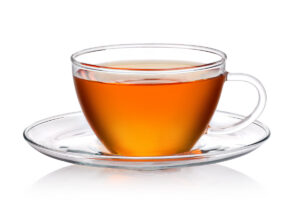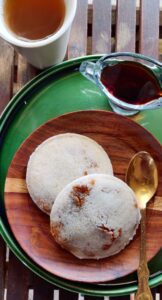“E cup laal saah,” which translates from Axomiya to English as ‘a cup of red tea,’ fuels the heart, soul, and bodies of the people of Assam. Given that it is the beverage of choice of the state that boasts of being the largest contiguous tea-growing region in the world, it is a cultural phenomenon worth exploring!

Contrary to popular belief, the British did not raise tea plantations in Assam with plants brought from China. In 1823, Robert Bruce, a Scottish adventurer sent to Assam on a ‘Company’ directive to search for tracts of land for growing tea, discovered tea plants growing in the jungles of Rangpur near Sibsagar. Bruce collected some of the leaf samples and sent them for tests to the botanical laboratories in Calcutta.
Unfortunately, Robert passed away a year later, but not before passing the information about the ‘tea-like’ plant on to his younger brother, Charles Bruce, a British naval and gunboat officer patrolling local waters. Bruce was born in Jorhat, Assam, and in 1824, was commander of a division of gunboats during the first Anglo-Burmese War. When the war ended in 1835, he was hired by the British East India Company to start tea plantations. The British first supplied him with Chinese tea plants and plantation workers, but their efforts yielded disastrous results when the Chinese plants cross-pollinated with the local species.
Acting on his own initiative, Charles used the Chinese workers to convert a tract of land in Sadiya into a nursery to grow the indigenous ‘tea plant.’ In 1836, he dispatched a small tea sample to the Tea Committee in Delhi and some plants to the Botanical Gardens in Calcutta for study. The Viceroy Lord Auckland appreciated the tea made from the first samples, and botanical experts determined that the plant growing in the jungles of Assam was indeed tea and of outstanding quality. In 1837, Bruce delivered 46 chests filled with Assam tea, and in 1839, eight chests weighing 350 pounds were auctioned in Mincing Lane, London.
Thousands of acres of jungle were cleared to plant Camellia Sinensis var. Assamica, or Assam tea, which soon became the largest source of colonial revenue and the preferred cuppa.
Most of the tea grown in Assam is mass-marketed, and in a country that largely prefers its tea milky and sweet, the distinctly rich, full-bodied decoction is preferred with a splash or two of milk. Even across the world, its most recalled value is its strong and rich taste that earns it the label of breakfast tea, perfect to wake up with but mostly with a splash of milk! However, the people who grow it and have grown up around it know it better. Whether it is the Sighpo tribes who were the indigenous custodians, the tea tribes who worked in the plantations, or the people of the state, they have always known that its malty character and bright amber-colored liquors need no crutch of milk and is best experienced as laal saah – just the liquor, always served hot.
Whether served in tiny glass tumblers, simple cups, or fine chinaware, with a spritz of Assam’s indigenous lemon, the kaji nemu, or just by itself, laal saah unifies the states across class and creed.
The aristocratic laal saah needs one teaspoon of leaves per cup of the coveted second flush, preferably the golden tips, steeped for 3-5 minutes in the water straight off the boil and strained into fine China teapots kept warm with embroidered tea cozies. The discerning memsahib will let you know that the tea strainer must be dipped in warm water before straining to ensure that no tea dust gets into the brew! One only passes the aristocratic laal saah test when the bottom of the cup is visible through the liquor. This brew of leisure demands to be poured into dainty teacups and served with a spoon of sugar! In the two hundred years of tea history, it is only the past twenty years that health consciousness has caused a rift between the tea and the sugar, which otherwise nestled amorously to make the perfect brew, every once in a summer afternoon, allying with a slice of lemon to give rise to the refreshing nemu saah or lemon tea.
Laal Saah
Instructions
- Boil water in a kettle.
- Add one teaspoon leaf tea per cup into a teapot and pour in the hot water. If you are using CTC tea, a good way of getting a clear, aromatic laal saah is to dip a tea strainer into hot water. This forms a film and prevents any loose particles from getting into the tea. Take 1/2 teaspoon CTC tea in the strainer and pour hot water through it.
- Cover and steep for five minutes.
- Strain into cups and serve.
- Add sugar/honey or lemon or both to your tea and enjoy!
Winter mornings in Assam are foggy and misty and a time for Pitha or traditional sweetmeats made with newly harvested rice. On any such morning, as one treks through the markets and streets of any city or village of Assam, one is invariably greeted by the sight of Axomiya women in their beautifully woven mekhla-sadors, making tekeli pitha, fluffy white, steamed rice cakes stuffed with sweet coconut filling, served with glasses of piping hot laal saah! At home, the breakfasts can be of traditional rice derivates like sira, flattened rice, or xandoh guri, toasted, parboiled rice powder served with curd, milk, or as porridge or dishes suited to modern palates. In festivities and ceremonial occasions, the breakfast plate is filled with deep-fried puffed bread and lusi, served with a potato and white pea curry. The cup of laal saah stands guard, supporting and uplifting these gastronomical delights irrespective of changing scenes, seasons, or reasons.

But it isn’t as if it recedes as the sun rises higher! Every neighborhood, market, and office complex has its beating heart in the roadside tea shops, the saah Dukan, or the gums, as they are called. A large aluminum kettle was constantly on the boil, getting respite only to pour out amber tea into cups. Mid-morning or late afternoons are the busiest, with clusters of co-workers taking a break from work, while evenings bring together friends or strangers catching up on local gossip and world news over steaming cups! The glass jars filled with sweet/savory biscuits and cookies and flaky, fried pieces of dough called nimki exist to enhance the experience of the local saah! No one worth their tea ever recalled a shop for its stellar nimki, the recommendations are always based on the finesse or strength of the laal saah, as one prefers it to be.
Now, one sees more and more milky, strong brews served by this saah dukaan, a sign of changing times and urban demographics. Nonetheless, the laal saah holds its ground. Not just because it is bound by love to the average Axomiya. It is widely believed that doing away with the milk helps avoid acidity and gastric problems caused by the multiple cups of tea that most Axomiyas drink throughout the day. The laal saah is also believed to aid in digestion. The burden of guilt is thus reduced by shedding the lactose! A rule that is curiously inverted for children and tea is added to the list of forbidden items, especially the laal saah, considered too potent for a child’s stomach. Fooled often by the few drops of tea liquor added to a glass of milk and lured by the forbidden, children grow into adults who take to the cup with a vengeance and resolve to make up for the lost years. The unbroken saga of the laal saah thus continues.
“E cup saah khabo, ahok,” ‘come have a cup of tea with us’ is the cornerstone of social grace and etiquette for an Axomiya. And tea is preferred laal. So, the next time you decide to enjoy a cup of tea, pause and recall how the nurturer of the tea bushes drinks it and do away with the milk. After all, in the rolling tea plantations of the state, local saah is the way tea is meant to be drunk!
Tea Market
Get More Value from Your Tea: BRU Maker One
+41794574278
Jacque's Organics
(647) 804-7263